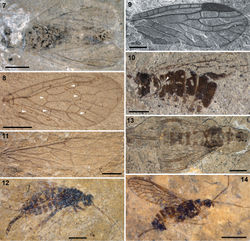Nanosialis ponomarenkoi
| Notice: | This page is derived from the original publication listed below, whose author(s) should always be credited. Further contributors may edit and improve the content of this page and, consequently, need to be credited as well (see page history). Any assessment of factual correctness requires a careful review of the original article as well as of subsequent contributions.
If you are uncertain whether your planned contribution is correct or not, we suggest that you use the associated discussion page instead of editing the page directly. This page should be cited as follows (rationale):
Citation formats to copy and paste
BibTeX: @article{Shcherbakov2013ZooKeys358, RIS/ Endnote: TY - JOUR Wikipedia/ Citizendium: <ref name="Shcherbakov2013ZooKeys358">{{Citation See also the citation download page at the journal. |
Ordo: Panmegaloptera
Familia: Nanosialidae
Genus: Nanosialis
Name
Nanosialis ponomarenkoi Shcherbakov, 2013 sp. n. – Wikispecies link – ZooBank link – Pensoft Profile
Holotype
Forewing PIN 3840/2603A (part and counterpart).
Description
Forewing 3.0 mm long, elongate (2.7:1), narrowly rounded posterior to MA apex; 7 Sc veinlets; pterostigma distally translucent, with 2 veinlets inside; RP base and crossveins ir1, ir2 transverse, not far separated; ir1 at base of pterostigma; mp cell single, rather long; MP1 3-branched, pectinate backwards; MP2 2-branched; CuA simple; anal area 1/2 wing length; two anal veins (2A+3A with 3 branches), delimiting one anal cell.
Adult PIN 3840/2604A (part and counterpart; head, prothorax, legs, right wings, and apex of abdomen beyond 6th segment, missing; left forewing and hind wing plaited and superimposed, as clearly seen in their pterostigmal areas). Tentatively assigned to the same species on account of similar size and reconstructed forewing venation (differing from the holotype in the larger mp cell and more separated ir1 and ir2 crossveins). Hind wing with well-developed pterostigma. Body as preserved ~2 mm long, somewhat depressed dorsoventrally. Mesoscutum 0.7 mm wide, transverse oval (1.9:1), deeply convex; narrow anterior zone laterally cut off by deep grooves; adjacent third steeply sloped, with semicircular median lobe delimited by arched lines; mesoscutellum low triangular, delimited by deep grooves, with posterior margin slightly arched; mesopostnotum rather narrow. Metascutum 0.55 mm wide, ×1.3 narrower and twice shorter than mesoscutum, subtriangular, more flat, with anterior margin concave, area of metascutellum slightly upturned (no scutoscutellar sutures), posterior margin subangulate; metapostnotum very narrow, arched. Abdomen ~0.7 mm wide, well sclerotized; 1st tergite short (especially medially), broadly sinuate anteriorly, with deep semicircular posterior notch nearly dividing it medially; 2–6th tergites longer, transverse (~2.5:1).
Etymology
Named after the paleoentomologist Alexander Ponomarenko.
Original Description
Images
|




